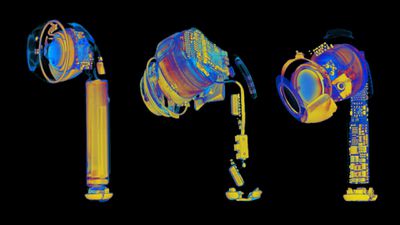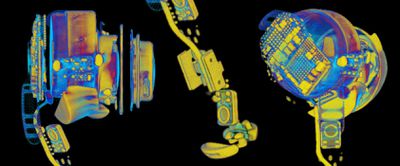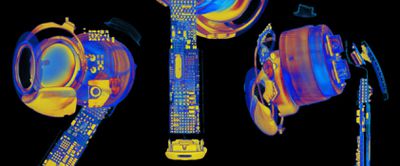New detailed CT scan images of the first-generation AirPods, AirPods Pro, and third-generation AirPods have revealed in detail what internal design changes Apple had to accomplish to include new features in every generation while continuing to miniaturize internal components.

The first-generation AirPods, announced in 2016, serve as the main design inspiration for the AirPods Pro and third-generation AirPods. The CT scan shows that the internal battery is the largest component in the first-gen AirPods, taking up the entire space of the long stem. In the earpiece, Apple's H1 chip finds its home and, at the bottom, a single downfacing microphone.
With the AirPods Pro, Apple's first update to the AirPods since their launch, the company had to completely rethink the internal structure and placement of components. Perhaps the most striking and noticeable change highlighted by the scans is the location of the battery.
The AirPods Pro nixed the long-stem design from the AirPods and Apple's classical EarBuds. Instead, Apple cut the stem to make the entire body shorter, meaning fitting a battery to provide sufficient charge into the smaller stem proved a challenge.

To counter this, Apple placed the battery in the head of the AirPods Pro. In the head, which grew in size compared to the first-gen AirPods, Apple also miniaturized different components into a single PCB, or printed circuit board, to allow for a smaller footprint. The AirPods Pro also included Adaptive EQ, which was enabled thanks to a third, new microphone placed in the head of AirPods Pro in front of the speaker.
In the stem, Apple also repositioned the microphones compared to the initial AirPods, now placing them higher and not directly coming out of the bottom of the stem. The removal of the battery from the stem of AirPods Pro allowed Apple to include force touch sensors, allowing users to squeeze the AirPods Pro to pause music, invoke Siri, and more.

The third-generation AirPods announced this past fall takes heavy inspiration from the AirPods Pro design but is a mix between the standard AirPods and the AirPods Pro in how it's internally built. Unlike the AirPods Pro, which features a primarily bare stem, the CT scan shows the third-generation AirPods' stem full of components and a few distributed sensors, similar to the first-gen AirPods. Like the AirPods Pro, the battery remains in the head of the AirPods alongside new skin-contact sensors.
Moving forward, Apple is expected to adopt an entirely new approach with the next-generation AirPods Pro, which will dispense with a stem altogether. The design and engineering lessons Apple has learned thus far with AirPods, such as being able to fit the battery in the head of the AirPods instead of the stem, are likely to come into greater play with the new AirPods Pro destined for launch in 2022.
The CT scan images were provided by "Scan of the Month," a website that takes popular products and puts them under a CT scan to uncover how they're designed and built. This month's AirPods website is a fun and interactive experience for those interested and can be found here.






















